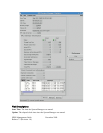Thread Pool Size and/or Request Queue Size to help with the System Manager performance.
However, increasing these 2 parameters could cause the System Manager to require more
memory.
• Data Change Notifications. The number of data change notifications received from servers.
(Server RPC Interface only).
• Unsolicited Notifications. The number of notifications which the System Manager received from
other HPSS servers but which it did not request from them. (Server RPC Interface only).
• Log Messages. The number of log message notifications processed. (Server RPC Interface only).
• Tape Check-In Messages. The number of tape check-in request notifications received. (Server
RPC Interface only).
• Tape Mount Messages. The number of tape mount request notifications received. (Server RPC
Interface only).
• Total RPCs. Total number of RPCs processed by the RPC interface.
Client Connection Information. Information about clients that have connected to the System Manager.
• Maximum Connections. The maximum number of client connections that the System Manager
was handling at any one time. Each client can have multiple connections. The default connections
per client is 2. Each client can specify the number of connections using the
-Dhpss.ssm.SMConnections Java command line option.
• Current Connection Count. The number of client connections currently being handled by the
System Manager.
• Current Client Count. The number of clients currently connected to the System Manager. This
will be the number of entries in the Client List (below) with an In Use state.
• Client List. The list of clients connected to the System Manager. The entries that appear in the
client list will be for (up to) the last 64 (SSM_CLIENT_MAX) clients that have connected to the
System Manager.
• ID. Slot identifier.
• State. Clients displayed in the client list can have one of two states: In Use and Free.
• In Use. The clients that are currently connected to the System Manager.
• Free. The clients that were once connected but are no longer connected (active).
Once the client list contains SSM_CLIENT_MAX In Use and/or Free entries, then the oldest Free
slot (the client that has been disconnected the longest) is given to the next client. Once all the slots
are In Use, then the client table is full; no new clients can connect until one of the In Use slots
becomes Free after a client disconnects.
• User Auth. The client user's authorization level: admin or operator. See Section 3.3:
Configuration and Startup of hpssgui and hpssadm on page 34 for more details.
• Principal. The user's principal name.
HPSS Management Guide November 2009
Release 7.3 (Revision 1.0) 66


















